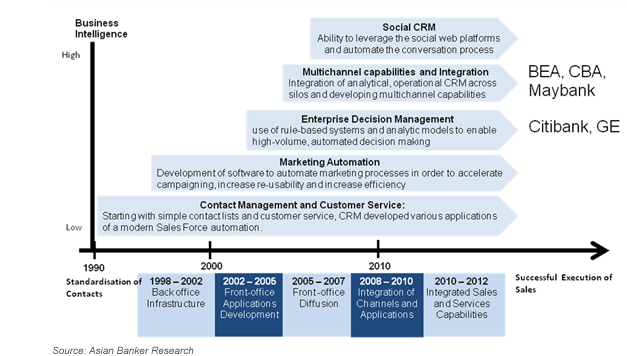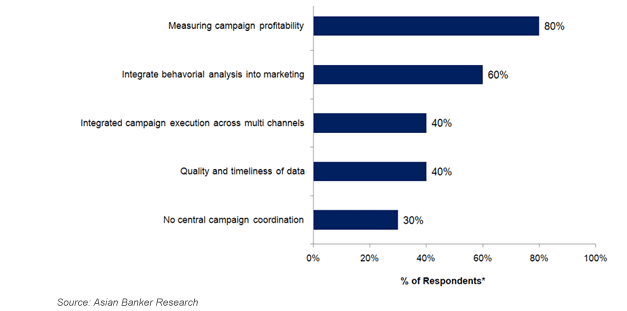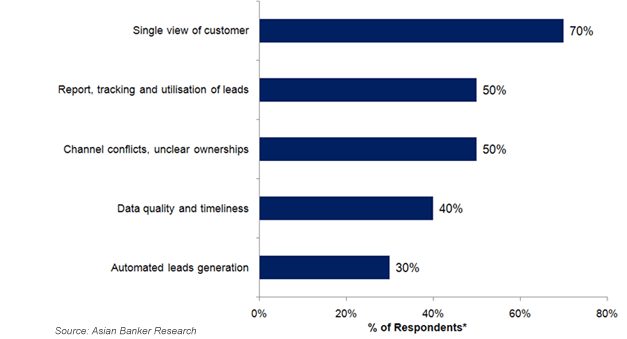While sales and service integration proceeds, banks still struggle in measuring campaign profitability
By Research
Despite a refined and more granular segmentation, higher campaign automation and centralised campaign management, most banks in the region still rely heavily on untargeted and unsolicited marketing.
The majority of banks in emerging markets still operate in silos along their business lines, with inter-departmental cooperation and information sharing extremely limited. Sales and service integration has come a long way from the beginning of Customer Relationship Management (CRM) in the 1990s. Starting from contact management and customer service, more and more features were added over time.
Best practice banks in the region, such as those in Hong Kong, Singapore and Australia, have realised integrated sales and services structures as well as implemented and executed multi-channel capabilities and real time dynamic offers.
Figure 1. Evolution of customer relationship management
 Please click to view enlarged image
Please click to view enlarged image
Malaysia
Several Malaysian banks have entered a relatively advanced state of analytical capabilities, having deployed behavioural analysis and data models such as propensity to buy, predictive models, profitability models and churn analysis. These banks currently focus on the integration of channels and business lines. The development goes to a more centralised management of customer data, striving for a single view of the customer. Core banking integration is not there yet, but will be the next reasonable step for best practice banks. With the latest series of IT upgrades, campaign automation and monitoring is a major issue in Malaysian banks. However, several interviewees stated that processes often remain dependent on manual intervention. Personalisation of marketing, services and products for the mass segment is at an early stage, but huge volumes still cause some difficulties. A few banks have already introduced personalised event based marketing capabilities, but the majority of the banks are still able only to market according to general segmentation.
India
In India, basic segmentation is now available in most banks, but the analytical skills to deploy target marketing and customised offers are limited to international and big private banks. The latter have already started integrating their sales and services infrastructure across banks and even across groups. Advanced types of analysis, such as behavioural analyses are deployed and campaigned, and channel efficiencies are measured frequently. Although Indian public sector banks have realised the importance of sophisticated segmentation methods and are determined to catch up with private sector banks, their current level is still very low. A senior representative of a major public bank in India stated: “We have not yet segmented our customers, but we do study customer behaviour of a small sample group. We hope to get some insights and also train our people to adopt a new business style. This is the major challenge at the moment.” Weak back office capabilities and insufficient internal communication further limit centralisation of sales and marketing initiatives. One reason for these weaknesses is the vast geographical spread of major Indian banks, which result in considerable differences of IT infrastructure within a single bank institution across India.
Indonesia
Several banks in Indonesia are tracking customer behaviour and adjusting their marketing and sales offers towards the needs of the customer. A major Indonesian bank said, “We have detailed campaign marketing reports and we monitor the outcome of each campaign. So we roughly know, if it is performing at the desired benchmark or not. Benchmarks depend on their nature, such as revenue benchmarks, loss benchmarks, volume benchmarks. That is how we know whether campaigns are performing or not; which worked and which didn’t.” Some banks test their marketing strategies carefully based on the responses of customers, when exploring new segments. However, banks continue to focus on mass campaigning and product-push. Personalisation of marketing and products is not an issue in Indonesia yet.
Thailand
Banks in Thailand are currently working on centralising and integrating customer information across several business lines to achieve a singular view of customers. But this process is only at its birth stages and poses massive difficulties due to the various source systems, data formats and the poor quality of data. Several banks benefits from technology, and knowledge transfers from cooperation with regional and foreign banks. Poor segmentation and data analytics capabilities limit offers and product personalisation. Instead, banks rather follow basic segmentation according to occupation, gender, etc. even if behavioural analysis is not yet implemented. Campaigning is still on a basic level, which usually means mass campaigning. As most banks are not able to manage campaigns properly, it results in over-selling to customers due to poor contact protocol and contact management integration in the marketing process. Slow sales process, long follow-up times on leads and complicated and time-consuming approval processes negatively affect conversion rates.
Key challenges areas
The survey asked 4 top tier banks in Thailand and 6 top tier banks Indonesia for their top five challenges in the following aspects of sales and services integration: “What are the key challenges in …?”
Figure 2. Challenges in campaign management
 Please click to view enlarged image
Please click to view enlarged image
Almost 80% of the respondents in our survey rated measuring campaign profitability as among their top challenges citing limited analytical capabilities, low frequency and manual intervention as the main causes of these challenges. Around 60% of the targeted banks found it difficult to integrate behavioural analysis into marketing as segmentation is still too rough and a there is a lack of focus on mass marketing. Driving campaigns through multiple channels was a challenge for about 40% of respondents, these challenges caused by lack of internal communication, unclear processes and responsibilities and coordination. As most CRM systems in emerging markets have only been implemented in recent years, data quality and quantity is not sufficient. Leading banks in Asia Pacific said that it takes at least 3-4 years until the data coverage becomes usable, with lean focus taking even longer. 40% percent stated this as a problem for their campaign management capability. 30% named their siloed approach and the lack of a centralised marketing department as a major problem. As a result of this issue, poor coordination, customer overselling and insufficient campaigns exist within the bank.
Figure 3. Challenges in leads management
 Please click to view enlarged image
Please click to view enlarged image
Achieving a single view of customer is seen as a challenge by 70% of the banks in Thailand and Indonesia as diverse termini for the same subject exist across different departments, different file formats and data requirements, deriving from the independent development of IT and processes within siloes. 50% stated they have problems to utilise leads fully caused by unsatisfactory channel efficiency affecting tracking and reporting and therefore delays leads distribution and sales performance. Channel conflicts and unclear ownerships pose a major problem for 50% of our respondents. Again this is caused by weak internal processes, unclear responsibilities and coordination and often a siloed structure. Lastly, leads automation is an issue for 30% of respondents.
Keywords: Data Silos, Best Practices, Infrastructure, Customer Behaviour









Leave your Comments